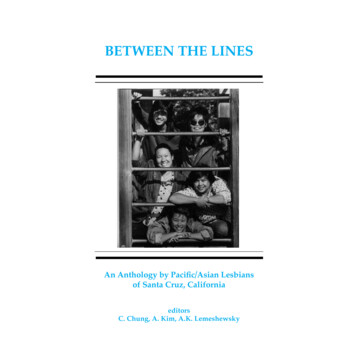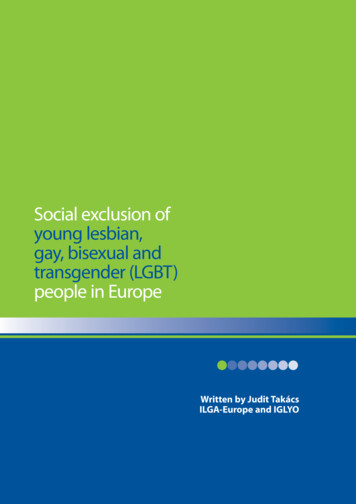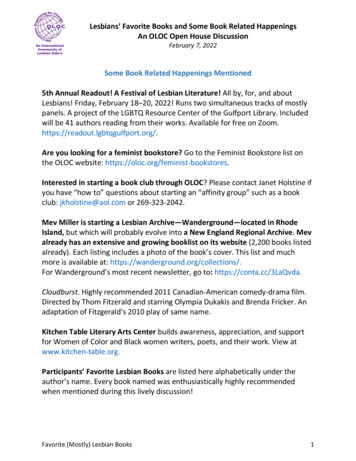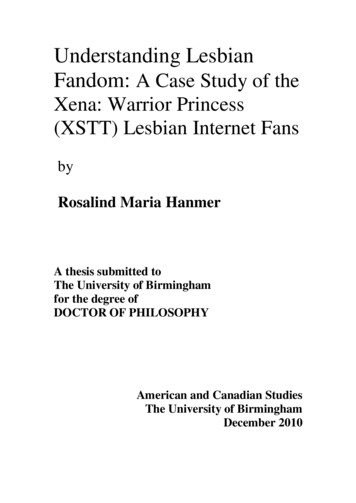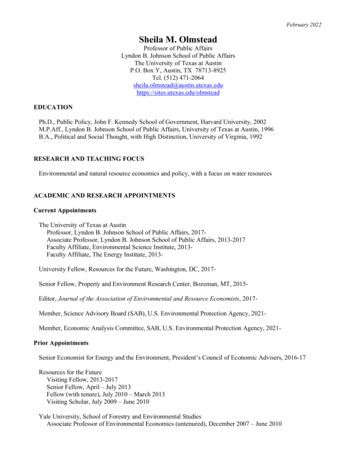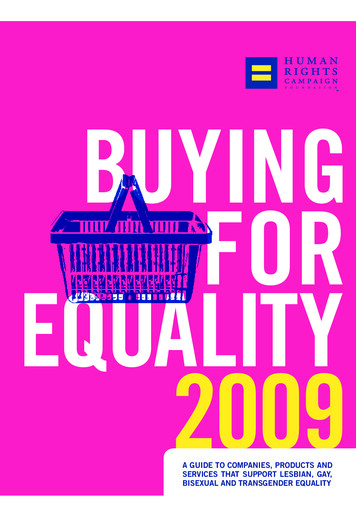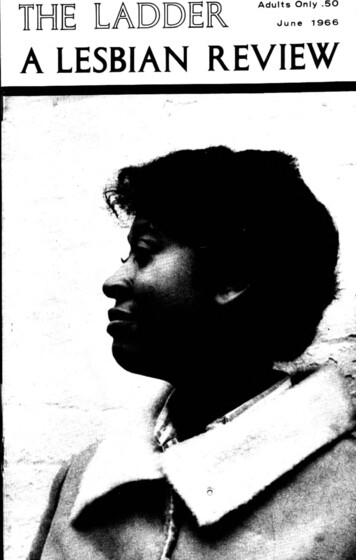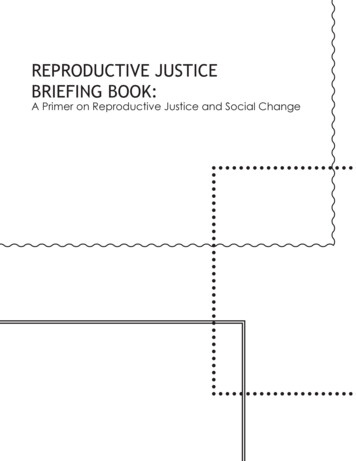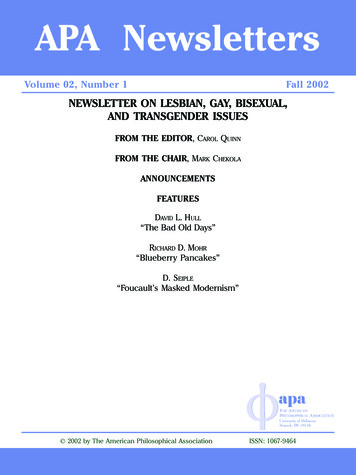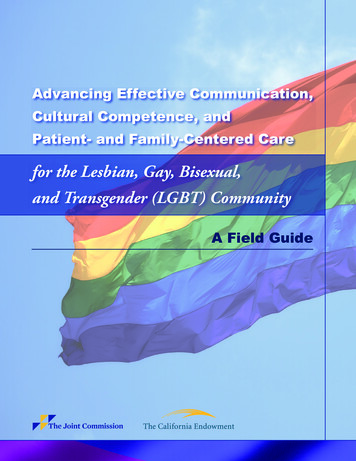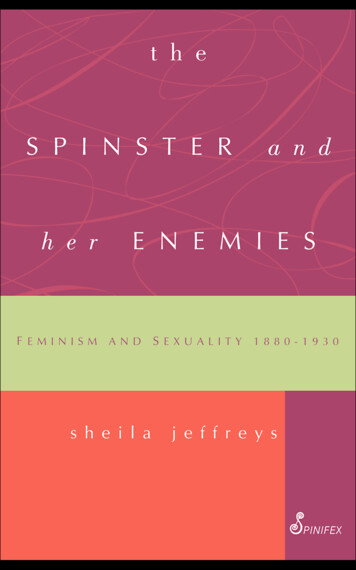
Transcription
Sheila Jeffreys is a lesbian and a revolutionary feminist who has beenactive in feminist campaigns against male violence, pornography andprostitution in Britain and in Australia for twenty years. She is aSenior Lecturer in the Department of Political Science at the Universityof Melbourne, where she teaches sexual politics and lesbian and gaypolitics. She has written three previous books on the politics ofsexuality, Anticlimax: A Feminist Perspective on the Sexual Revolution(1990), The Lesbian Heresy: A Feminist Perspective on the LesbianSexual Revolution (1993), and The Idea of Prostitution (1997).
OTHER BOOKS BY SHEILA JEFFREYSAnticlimax: A Feminist Perspective on the Sexual Revolution(1990)The Lesbian Heresy: A Feminist Perspective on the LesbianSexual Revolution (1993)The Idea of Prostitution (1997)The Sexuality Papers: Male Sexuality and the Social Controlof Women (1987) Co-editorNot a Passing Phase: Reclaiming Lesbians in History (1989)Contributing editor
THE SPINSTERAND HER ENEMIESFEMINISM AND SEXUALITY 1880–1930Sheila Jeffreys
Spinifex Press Pty Ltd504 Queensberry StreetNorth Melbourne, Vic. spinifexpress.com.au/ womenCopyright Sheila Jeffreys, 1985First published by Pandora Press, LondonThis edition published by Spinifex Press, 1997Copyright introduction to this edition Sheila Jeffreys, 1997All rights reserved. Without limiting the rights under copyrightreserved above, no part of this publication may be reproduced, storedin or introduced into a retrieval system, or transmitted, in any formor by any means (electronic, mechanical, photocopying, recordingor otherwise), without prior written permission of both the copyrightowner and the above publisher of the book.Copying for educational purposesWhere copies of part or the whole of the book are made under partVB of the Copyright Act, the law requires that prescribed proceduresbe followed. For information, contact the Copyright Agency Limited.Cover design by Kim RobertsMade and printed in Australia by Australian Print GroupNational Library of AustraliaCataloguing-in-Publication data:Jeffreys, Sheila.The spinster and her enemies: feminism and sexuality, 1880–1930.{New ed.}.Bibliography.Includes index.ISBN 1 875559 63 91. Feminism—England—History. 2. Sexual ethics for women—England—History. 3. Single women—England—Sexualbehaviour—History. I. Title305.420942
CONTENTSAcknowledgmentsviiPreface to 1997 editionixIntroduction1 Feminism and Social Purity162 Continence and Psychic Love273 ‘The sort of thing that might happen to any man’:Feminist campaigns and politics around the sexualabuse of children544 ‘Henpecking’: Women’s campaigns to gainlegislation against the sexual abuse of girls725 Spinsterhood and Celibacy866 Women’s Friendships and Lesbianism1027 Antifeminism and Sex Reform before the FirstWorld War1288 The Decline of Militant Feminism1479 The Invention of the Frigid Woman16510 The ‘Prudes’ and the ‘Progressives’186v
7vi
ACKNOWLEDGMENTSIn the Patriarchy Study Group from 1978 to 1981 I was able torefine my ideas on sexuality through weekends of intense andexciting discussion with other revolutionary feminists includingAl Garthwaite, Jackie Plaister, Lal Coveney, Leslie Kay,Margaret Jackson, Marianne Hester, Pat Mahoney, SandraMcNeill, Valerie Sinclair. I am grateful to them all. The lesbiansI have worked with in Women against Violence against Womenhave sustained me both personally and politically, particularlyLinda Bellos and Jill Radford. I would like to thank the womenin the South West London Women’s Studies Group throughwhich I was launched into women’s studies teaching, and thewomen in my classes who have been consistently supportiveand encouraging.I would like to thank those who gave me practical help inmy research. I am grateful to Jalna Hanmer and Hilary Roseof the Department of Applied Social Studies at the University ofBrad-ford for encouraging me to take up research and providingthe facilities to begin this project. David Doughan of the FawcettLibrary has shown unfailing interest and given me invaluableassistance. Special thanks to Maggie Christie who compiledthe index and to my editor, Philippa Brewster.Most of all I am indebted to Carolle S.Berry for the love andsupport which she has given me throughout the writing of thisbook. She has spent a great number of hours listening to me,contributing her thoughts and clarifications and organising pilesof papers and lists of what I was to do next.If this acknowledgments page sounds like a tribute towomens’s love and friendship that is because it is that love andfriendship that has enabled me to keep my ideas running againstthe grain for so long.vii
PREFACE TO 1997 EDITIONI began the research which became this book in 1978. At thattime I was involved in the recently formed Leeds Rape CrisisCentre in the UK. I was concerned to develop my knowledgeand responses to child sexual abuse, a form of men’s sexualviolence which was just becoming an important issue for feministtheorists and activists (Armstrong, 1978; Rush, 1980). At thistime we were quite unaware that this issue had been central tothe concerns of a previous generation of feminists. I was anhistorian by training and was amazed to discover in the FawcettLibrary, a library of resources and archives on women’s history,that there had been a massive feminist campaign against men’ssexual abuse of children in the late nineteenth and earlytwentieth centuries of which contemporary feminists knew almostnothing. I was excited to find out that the ideas and tactics ofour foresisters were so similar to those we had reinvented in the1970s.I discovered that this campaign was wide ranging. It wasdirected to changing attitudes to and treatment of the victims,gaining heavier sentences for male abusers and changing thelaws to raise the age of consent. Feminists involved developedideas about sexuality which challenged the double standard,rape and the compulsory nature of sexual intercourse. Inparticular they mounted a great challenge to men’s prerogativesof sexual access to women, to prostituted women, to children,to resistant wives, and supported the ideas of spinsterhood andcelibacy. The campaign went on for over fifty years. I wantedto know why it had subsided. As I pursued this detective story itbecame clear to me that a change in the ideology of sexualitywas instrumental in undermining the feminist campaign. Thischange was created by the new ‘science’ of sexology. With allthe authority of science, sexology promoted precisely the formix
PREFACE TO 1997 EDITIONof male sexual behaviour the feminists were challenging: maledominance and aggression and female submission.In the early 1980s feminist campaigners against maleviolence, like myself and others in the London RevolutionaryFeminist Anti-Pornography Group, Women Against ViolenceAgainst Women (WAVAW), and those in rape crisis centres,were dismayed to discover the direction that some feministthinkers on sexuality were taking. Our belief that male sexualviolence could only be challenged by transforming malesexuality, dismantling the dominance/submission model andcreating a very different feminist sexuality, was opposed bysexual libertarianism. We read the 1981 Sex Issue of Heresiesfrom the US in which Pat Califia argued for lesbiansadomasochism as exciting sex and Paula Webster argued thatpornography and feminism were compatible becausepornography would provide women with exciting fantasies andpossibilities about sex (Califia, 1981; Webster, 1981). Thecollection of writings on sadomasochism from the Californiangroup Samois, Coming to Power, provided both seedy scenariosand intellectual justifications of the practice (Samois, 1982). Aserious opposition to the feminist anti-pornography campaigndeveloped when the ordinance drawn up by Andrea Dworkinand Catharine MacKinnon was opposed in the US by the FeministAnti-Censorship Taskforce (FACT), (Duggan and Hunter, 1995).It had not occurred to those of us involved in feminist campaignsagainst male violence and pornography that a lobby group ofwomen purporting to be feminists would defend precisely thepractices we considered fundamental to the oppression of women.Many of these sexual libertarian women were pro-pornography;intent on gaining for women sexual ‘subjectivity’ which couldonly be obtained by turning other women into objects in thevarious practices of the sex industry.The history that I had been so pleased to discover now becamecontentious. The two very different sides of what came to becalled the ‘feminist sexuality debates’ both sought to enlist historyin support of their causes. I was rediscovering my fore-sisters’work with admiration and respect. Sexual libertarians used itas an object lesson in the terrible dangers of being antiprostitution and against what they saw as sexual freedom. Theysought to demonstrate that contemporary anti-pornographyfeminists were mistakenly imitating the discredited anddangerous practices of their foresisters. Lisa Duggan, a memberof FACT, asserts that all feminist historians in the US in thex
PREFACE TO 1997 EDITIONmid-1980s supported FACT because their study of history madethem recognise the dangers of the ordinance (Duggan, 1995).Sexuality in the late nineteenth and early twentieth centurieswas suddenly the centre of attention and the subject of furiousdiscussion.Some sexual libertarians chose as their heroes from the earlierperiod, not women, but the male sexologists whose work hadbeen so influential in undermining feminist anti-violence ideas.That was a surprise. The American proponent of sadomasochism,Gayle Rubin, a Samois member, is a good example. Rubintook issue with my approach to the sexologists of this periodsuch as Henry Havelock Ellis whom I portray as consolidatinga male supremacist view of women and the idea that sex wasinevitably about male dominance and female submission. Notsurprisingly, since she is pro-sadomasochism, Rubin sees herlife’s work as being in the tradition of Ellis’ sexology, whichshe calls the pro-sex tradition. She labels the position of feministanti-sexual violence campaigners of this earlier period as antisexand puts me solidly in the conservative tradition.The conservative tradition has promoted opposition topornography, prostitution, homosexuality, all eroticvariation The opposing, pro-sex tradition has includedindividuals like Havelock Ellis, Magnus Hirschfeld, AlfredKinsey, and Victoria Woodhull Surely they are closer tothe spirit of modern feminism than are moral crusaders, thesocial purity movement, and anti-vice organisations Thecurrent feminist demonology generally elevates the anti-vicecrusaders to positions of ancestral honour, while condemningthe more liberatory tradition as anti-feminist. In an essaythat exemplifies some of these trends, Sheila Jeffreys blamesHavelock Ellis (Rubin, 1984, p.302).Rubin’s piece, Thinking Sex’, has been very influential in theintervening period, being reprinted in 1993 as the leading articlein the first anthology on lesbian and gay studies (Rubin, 1993).The difference in position between those of Rubin’s persuasionand radical feminist anti-violence activists like myself is not atrivial one but goes to the heart of the feminist project. Rubinargues that sexuality can be separated from ‘gender’. She suggeststhat sexuality is a separate system of oppression in which thesexual minorities, including sadomasochists and paedophilesare constrained. Her relabelling of sexual abuse of children as‘intergenerational sex’ was a significant development. Therexi
PREFACE TO 1997 EDITIONwas now a tendency, identified by some with feminism, whichsaw sexual abuse of children as acceptable and unfairlycondemned.Feminists should not, Rubin says, think that a feministanalysis will enable them to examine all that which pertains tosexuality. They should accept that there is much about whichthey cannot reasonably know. The proper experts, it turns out,are Rubin, a sadomasochist, and the denizens, mostly gay men,of the other minorities. Gradually Rubin’s analysis and that ofJeffrey Weeks, whose ideas resemble hers to a considerableextent, have become the standard gay male and now queerapproach to theorising sexuality, an approach intensely hostileto the temerity of feminist critics who think they have the rightto write about sexuality and challenge the traditional male sexuallibertarian consensus (Weeks, 1985).In the 1993 republication of ‘Thinking Sex’, Rubin notesthat the intellectual landscape of the history of sex has changedin a worrying direction. Trends she identifies in her text aselevating ‘anti-vice crusaders to positions of ancestral honour,while condemning the more liberatory tradition as anti-feminist’have become ‘much more fully articulated’ (Rubin, 1993, p.29).The key texts in this new tradition she identifies as The Spinsterand Her Enemies; Anticlimax (Jeffreys, 1990); The SexualityPapers, a collection of writings on the history of sex by thePatriarchy Study Group (a group of British revolutionaryfeminists), in which I developed my ideas, (Coveney, Jackson,Jeffreys, Kaye, Mahony, 1984); and the American collectionThe Sexual Liberals and the Attack on Feminism (Leidholdtand Raymond, 1990). To this list must be added MargaretJackson’s The Real Facts of Life which continues the examinationof nineteenth- and early-twentieth-century feminist ideas andactivities around sexuality and the critique of sexology (Jackson,1994). Margaret Jackson was also a member of the PatriarchyStudy Group when this challenging analysis of sexuality wasformed. It is good to know that there is now a clearlyrecognisable body of work from a radical feminist traditionwhich presents an uncompromisingly critical analysis of themale supremacist history and ‘science’ of sex.The degree to which Spinster upset the conventional sexuallibertarian history of sexuality is demonstrated by the detailedrepudiation of the book’s ideas which forms the heart of the‘Perverse Politics: Lesbian Issues’ edition of the British socialistfeminist journal Feminist Review. The editors of the issue, Ingexii
PREFACE TO 1997 EDITIONBlackman, Mary McIntosh, Sue O’Sullivan, Pratibha Parmarand Alison Read say they will challenge the feministantipornography campaigns taking place in the UK at that timewhich they accuse of having ‘grossly distorted the issues byrelying on a simplistic moralism and a crude essentialism’(Blackman et al., 1990, p.2). This issue is the antidote. Itcontains a piece by Mary Hunt, a sexual libertarian Americanlesbian, entitled, The De-eroticisation of Women’s Liberation:Social Purity Movements and the Revolutionary Feminism ofSheila Jeffreys’. Hunt makes it clear that her main concern iswith the radical/revolutionary feminist critique ofsadomasochism as a sexual practice. She was an angry critic ofa speech I made at a conference in 1987 in Massachusetts on‘Sexuality and Power’ which was entitled, ‘Eroticising women’ssubordination from Havelock Ellis to Gayle Rubin’. Her critiquehere centres on my interpretation of nineteenth-century feministanti-sexual violence campaigners.According to Hunt, my book reflects a tradition of‘revolutionary feminism (or “radical feminism” as we tend tocall it in the USA)’ which defines ‘the vast majority of womenin the world as helpless victims who need to be saved’ (Hunt,1990, p.24). The revolutionary feminist approach is ‘reductionistand exclusionary’, ‘disturbing’, ‘uncritical’, ‘astounding’. Thiswas a surprise since I had done my best to complicate thediscussion of this period in the history of sexuality and soughtto show exactly what late-nineteenth-century feminists werethinking. Some of their ideas could be seen as approximatingto traditional morality, whilst others constituted radicaltransformations of thinking about sex; questioning all of men’sprerogatives within marriage and without, questioning thebiological imperative and the double standard, and the authorityof fathers. An enthusiasm for pornography seems to inspire herrage at my work. Some women, she says, ‘like and feelempowered by pornography’ (Ibid., p.43). The revolutionaryfeminist approach would ‘keep us tied to the most cautious,conformist, guilt-ridden and rigid of personal, ideological andsexual styles’ (Ibid., p.40). In the same year that her angrycritique was published, my second book, Anticlimax, developedan even more detailed analysis of what was wrong with thesexuality of dominance and submission and called for the pursuitof ‘homosexual desire’ or a sexuality which eroticised equalityinstead of the eroticised difference of power which wasexemplified in ‘heterosexual desire’ (Jeffreys, 1990). Since I wasxiii
PREFACE TO 1997 EDITIONaccused of single handedly ‘de-eroticising’ women’s liberationwith Spinster, I expect that Anticlimax was even more enraging.There is another way in which The Spinster and Her Enemieshas been seen as both useful and contentious and that is in itscontribution to the history of lesbianism in Britain. Two feministanthologies have used sections from my chapter on ‘Women’sFriendships and Lesbianism’ to demonstrate the socialconstructionist approach to the history of sexuality andlesbianism (Evans, 1993; Jackson and Scott, 1996). Spinsterprovides a positive interpretation of the history of spinsterhoodand relationships between women and, I hope, a positive heritagefor those determined spinsters and lesbians who today rejectthe masculine construction of women as destined solely to servemen and male sexuality. This approach to British lesbian historywas further developed in Not a Passing Phase, which includespieces by me and other members of the London Lesbian HistoryGroup (Lesbian History Group, 1989). It has been roundlycriticised by sexual libertarian lesbians whose model of lesbianidentity is based upon proven genital connection and roleplaying, for including in lesbian history women who were not‘real’ lesbians. In my third book, The Lesbian Heresy, I returnedto criticise the sexual libertarian approach to lesbian historyand contrast it with that of lesbian feminism, as well as analysingthe harmful effects of what I call the ‘lesbian sexual revolution’of the 1980s and 1990s in which the sex industry targetedlesbians with pornography, prostitution, stripping, sex toys and‘sex therapy’ (see Jeffreys, 1993, ch. 1).Most recently I have been engaged in writing The Idea ofProstitution (1997). I had been meaning to write at length aboutprostitution for some twenty years, since my anti-pornographywork of the late 1970s. The Idea of Prostitution is connectedwith my contemporary activism too. I have been involved infounding a local branch of the international Coalition AgainstTrafficking in Women (CATW) in Melbourne. The US directorsof CATW are Dorchen Leidholdt and Janice Raymond. Historyis important in this later book as well. I have chronicled theactivities of some of the same feminists I wrote about in Spinster,as well as the next generation of anti-prostitution campaignerswho were active between the two world wars. These womenworked through the League of Nations to outlaw men’s abuseof women in prostitution. In the 1980s prostitution becamenormalised in some areas of feminist thought as pornography,sadomasochism and paedophilia had been before. The Idea ofxiv
PREFACE TO 1997 EDITIONProstitution asserts that prostitution in fact constitutes men’ssexual violence and a violation of women’s human rights.The history of feminist campaigns and of lesbianism forms avital foundation for our campaigns against male violence todayand for lesbian feminist politics. There is still plenty of work tobe done. Feminist historical research and activism are integrallylinked. The history of sexuality will continue to be a source ofcontroversy. When sexuality is, as Spinster suggests and asradical feminist theorists such as Kate Millett and CatharineMacKinnon assert, the organising force of women’s oppression,the history of sexuality will be enlisted to justify either women’sresistance to men’s violence and what Carole Pateman calls the‘law of male sex-right’ or to support the male supremacist sexualsystem (Millett 1972; MacKinnon 1989; Pateman 1988). I amproud that Spinster provides no comfort for the male historiansof sexual liberalism and remain puzzled that any ‘feminist’theorists such as Rubin and Duggan, would want to reproducethat history and call it feminist. Women who celebratepornography and sadomasochism and call feminists ‘prudes’will not have the patriarchs shaking in their shoes. Feminism isabout making trouble after all; challenging masculine ideologiesand male behaviour. It was in 1880 and it is today.Brunswick Street, Melbourne, June 1997.xv
INTRODUCTIONThis book looks at a watershed period in the history of sexuality.The traditional historical interpretation of the years 1880–1930is that the sexual puritanism of Victorian England gave way tothe first sexual revolution of the twentieth century. From afeminist perspective the picture is different. This period witnesseda massive campaign by women to transform male sexualbehaviour and protect women from the effects of the exercise ofa form of male sexuality damaging to their interests. There islittle or no reference to this campaign in the histories of thewomen’s movement in Britain. Other aspects of the feministstruggle such as the suffrage campaign, the movement to improvewomen’s education and work opportunities and to gain changesin the marriage law, have all received attention. When historianshave mentioned the work of the same feminist campaigners inthe area of sexuality they have represented them as prudes andpuritans, criticising them for not embracing the goal of sexualfreedom or women’s sexual pleasure and finding in their writingsa source of useful humorous material. While their activitiesand demands have been seen as challenging and progressive inother areas, the activities of the very same women in the areaof sexuality have been seen as backward and retrogressive.The first five chapters look at the ideas and activities offeminist campaigners around sexuality. The first chapter dealswith the involvement of feminists in those organisations usuallyseen as purely conservative and anti-sex, for example, theNational Vigilance Association, the Moral Reform Union. Itexamines the way feminist concerns shaped social purity in the1880s and 1890s. It ends with a comparison of these earlierorganisations with the clearly non-feminist Alliance of Honour,whose membership was exclusively male, in the period beforethe First World War. The chapter entitled ‘Continence andPsychic Love’ examines the theories and strategies of those1
INTRODUCTIONfeminists who were involved in relationships with men. It looksin particular at the philosophy of sex developed by ElizabethWolstenholme Elmy and Francis Swiney. The next two chaptersare devoted to the women’s campaign against the sexual abuseof girls. This campaign has been chosen as an example ofpractical feminist activity where feminist theory was put intoeffect, because it was so extensive and wide-ranging and hasbeen substantially ignored by historians. The other major sexualissue on which feminists campaigned, prostitution, has receivedsome attention.1 The chapter on spinsterhood encompasses theideas and motivations of those feminists who were choosing toreject sexual relationships with men.There are certain basic assumptions underlying the work ofhistorians on the history of sexuality which must be overturnedif the significance of the women’s campaigns is to be understood.The most pervasive is the assumption that the last 100 yearsrepresent a story of progress from the darkness of Victorianprudery towards the light of sexual freedom.2 Implicit in thisview is the idea that there is an essence of sexuality which,though repressed at times in the past, is gradually fighting itsway free of the restrictions placed upon it. On examination this‘essence’ turns out to be heterosexual and the primaryunquestioned heterosexual practice to be that of sexualintercourse. Despite the wealth of work by sociologists andfeminists on the social construction of sexuality, the idea remainsthat a natural essence of sexuality exists.3 Another assumptionis that there is a unity of interests between men and women inthe area of sexuality, despite the fact that sexuality representsabove all a primary area of interaction between two groups ofpeople, men and women, who have very different access tosocial, economic and political power. Thus historians whoconcern themselves with writing the history of the ‘regulationof sexuality’, that is the way in which people’s sexual behaviourhas been restricted by repressive ideology and the state, withoutpaying serious attention to the way in which the powerrelationship between the sexes is played out on the field ofsexuality, can be seen to be subsuming the interests of womenwithin those of men.4 A most fundamental assumption is thatsexuality is private and personal. It may be understood thatsocial and political pressures influence what happens in thebedroom, but sexual behaviour is not recognised as having adynamic effect in its own right on the structuring of the powerrelationships in the world which surrounds the bedroom. When2
INTRODUCTIONsexuality is understood to be the most personal area of privatelife, it is not surprising that the women’s campaigns to set limitsto the exercise of male sexuality should be regarded withincomprehension or totally misunderstood. Ideas and campaignswhich are developing within the current wave of feminism giveus a very different basis for looking at the work of our foresisters.Contemporary feminists have detailed the effects upon womenof both the fear and the reality of rape, showing that the exerciseof male sexuality in the form of rape, functions as a form ofsocial control on women’s lives.5 Rape as social control has theeffect of restricting where women may go, what women maydo, and serves to ‘keep us in our place’ which is subordinate tomen, thereby helping to maintain male domination over women.Work is now being done by feminists on the damaging effectsupon women caused by the exercise of other aspects of malesexuality. The sexual abuse of children, prostitution,pornography and sexual harassment at work are all now beingdocumented and examined.6 Feminists are showing that thesesexual practices by men are crimes against women though theyhave consistently been represented as victimless forms of malebehaviour. Considering that contemporary feminists are havingto wage a difficult struggle to get forms of male behaviourwhich are essentially crimes against women taken seriously, itis not at all surprising that women’s campaigns around preciselythe same issues in the last wave of feminism are all but invisibleto contemporary historians. Much of the feminist theoreticalwork on male sexual behaviour and its effects on women hasbeen designed to show the ways in which sexual harassment inchildhood and in adulthood, at work, on the street and in thehome, restricts the lives and opportunities of women andgenerally undermines our confidence and self-respect. As theimpact of men’s sexual violence on all the different areas ofwomen’s lives is documented, it becomes clear that male sexualcontrol is of enormous importance in maintaining women’ssubordination. It is clear that we must look at the area ofsexuality, not as merely a sphere of personal fulfilment, but asa battleground; an arena of struggle and power relationshipsbetween the sexes.Current feminist debate on sexuality has gone futher than anexamination of the effects of male sexuality on women outsidethe home to a critique of the institution of heterosexuality andits role in the control and exploitation of women. Questions arenow being raised about the effects on women of the experience3
INTRODUCTIONof sexual activity within all heterosexual relationships in termsof the maintenance of male dominance and female submission.7Feminists are exploring ways of making it possible for morewomen to have real choices around sexuality, so that morethan a brave and embattled minority may have the right ofloving other women. Such questioning allows us to see thefeminists engaged in struggles around sexuality in previousgenerations not simply as the victims of a reactionary ideology,but as women manoeuvring, both to gain more power and controlwithin their own lives, and to remove the restrictions placedupon them by the exercise of male sexuality inside and outsidethe home.On the basis of this reassessment of what pre-First WorldWar feminist theorists and campaigners around sexuality weredoing, it is necessary also to reassess the significance of the socalled ‘sexual revolution’ of the 1920s. The propagandists ofsex reform in the 1920s and 1930s attacked the earlier feministsfor being prudes and puritans. Contemporary historians, forwhom the new ideology of the 1920s has become theconventional wisdom, have replicated this attack. When lookingat the 1920s they have been unable to be objective or critical.The last five chapters of this book examine the values andassumptions, and provide a new interpretation of this ‘sexualrevolution’.Chapter 6 looks at the way in which ideas about theacceptable form of women’s friendships was changed throughsexological prescriptions in the late nineteenth century, as thestereotype of the ‘real’ lesbian was created. The chapter on thesex reform movement before the First World War criticallyexamines the work of Havelock Ellis and other sexologists ofthe period. It shows how the feminist theory was underminedby the creation of a new prescription of correct female andmale sexual behaviour with all the authority of science. Malesexuality was characterised as active and aggressive and femalesexuality as pass
OTHER BOOKS BY SHEILA JEFFREYS Anticlimax: A Feminist Perspective on the Sexual Revolution (1990) The Lesbian Heresy: A Feminist Perspective on the Lesbian Sexual Revolution (1993) The Idea of Prostitution (1997) The Sexuality Papers: Male Sexuality and the Social Control of Women (1987) Co-editor Not a Passing Phase: Reclaiming Lesbians in .
